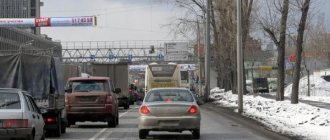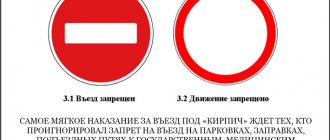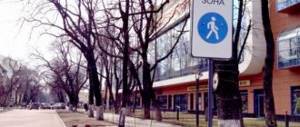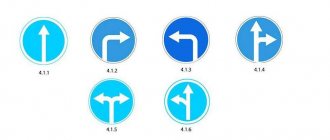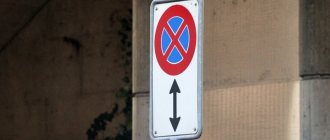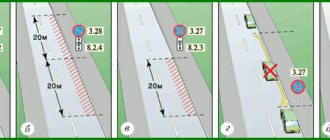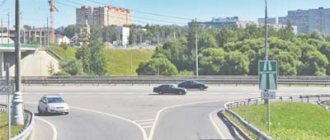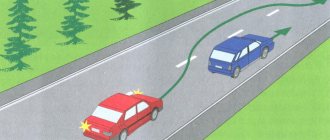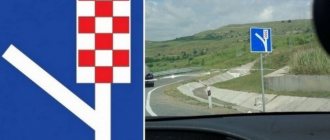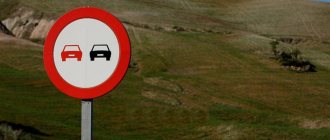| Number | Name | |||||
| 3.1 | No entryEntry of all vehicles in this direction is prohibited. This road sign can be seen on one-way roads, at the entrance opposite the direction of travel. The sign does not apply to: Route vehicles. Valid until the first intersection. We discussed this sign in detail in a separate article. | |||||
| 3.2 | Movement ProhibitionAll vehicles are prohibited. The sign does not apply to: 1) Vehicles of federal postal organizations that have a white diagonal stripe on the side surface on a blue background. 2) Vehicles that serve enterprises located in the designated zone, and also serve citizens or belong to citizens living or working in the designated zone. 3) For vehicles driven by disabled people of groups 1 and 2, transporting such disabled people or children of disabled people (Details here). 4) For route vehicles. Valid until the first intersection. We discussed this sign in detail in a separate article. | |||||
| 3.3 | Movement of motor vehicles is prohibitedThe movement of motor vehicles is prohibited. The sign does not apply to: *route vehicles; *vehicles driven by disabled people of groups I and II, transporting such disabled people or disabled children, if the identification sign “Disabled” is installed on these vehicles; *vehicles of federal postal service organizations that have a white diagonal stripe on the side surface on a blue background, and vehicles that serve enterprises located in the designated zone, and also serve citizens or belong to citizens living or working in the designated zone. In these cases, vehicles must enter and exit the designated area at the intersection closest to their destination. | |||||
| 3.4 | Truck traffic is prohibitedThe movement of trucks and vehicle combinations with a permissible maximum weight of more than 3.5 tons (if the weight is not indicated on the sign) or with a permissible maximum weight more than indicated on the sign, as well as tractors and self-propelled vehicles is prohibited. Sign 3.4 does not prohibit the movement of trucks intended for the transport of people, vehicles of federal postal organizations having a white diagonal stripe on the side surface on a blue background, as well as trucks without a trailer with a permissible maximum weight of not more than 26 tons that serve enterprises located in the designated area. In these cases, vehicles must enter and exit the designated area at the intersection closest to their destination. Valid until the first intersection. We discussed this sign in detail in a separate article. | |||||
| 3.5 | Motorcycles are prohibitedThe movement of two-wheeled motor vehicles (except mopeds) is prohibited. The sign does not apply to: 1) Vehicles of federal postal organizations that have a white diagonal stripe on the side surface on a blue background. 2) Vehicles that serve enterprises located in the designated zone, and also serve citizens or belong to citizens living or working in the designated zone. We reviewed all the signs for motorcycles and mopeds in a separate article. Valid until the first intersection. | |||||
| 3.6 | Tractor traffic is prohibitedThe movement of tractors and self-propelled vehicles is prohibited. The action does not apply to vehicles of federal postal service organizations that have a white diagonal stripe on the side surface on a blue background, and vehicles that serve enterprises located in the designated zone, as well as serve citizens or belong to citizens living or working in the designated zone. In these cases, vehicles must enter and exit the designated area at the intersection closest to their destination. Valid until the first intersection. | |||||
| 3.7 | Driving with a trailer is prohibitedTrucks and tractors with trailers of any kind are prohibited, and towing of vehicles is prohibited. The action does not apply to vehicles of federal postal service organizations that have a white diagonal stripe on the side surface on a blue background, and vehicles that serve enterprises located in the designated zone, as well as serve citizens or belong to citizens living or working in the designated zone. In these cases, vehicles must enter and exit the designated area at the intersection closest to their destination. Valid until the first intersection. | |||||
| 3.8 | Horse-drawn carriages are prohibitedThe movement of horse-drawn carts (sleighs), riding and pack animals, as well as the passage of livestock is prohibited. The action does not apply to vehicles of federal postal service organizations that have a white diagonal stripe on the side surface on a blue background, and vehicles that serve enterprises located in the designated zone, as well as serve citizens or belong to citizens living or working in the designated zone. In these cases, vehicles must enter and exit the designated area at the intersection closest to their destination. Valid until the first intersection. | |||||
| 3.9 | Bicycles are prohibitedBicycles and mopeds are prohibited. Valid until the first intersection. We discussed this sign in detail in a separate article. We looked at all the signs related to cyclists here. | |||||
| 3.10 | No PedestriansPedestrian traffic is prohibited. Valid until the first intersection. We discussed this sign in detail in a separate article. We looked at all the signs for pedestrians here. | |||||
| 3.11 | Weight limitationThe movement of vehicles (including trailers) whose total actual weight is greater than the number on the sign is prohibited. Valid until the first intersection. | |||||
| 3.12 | Limitation of weight per vehicle axleIt is prohibited to drive vehicles whose total actual weight on any axle exceeds the number on the sign. Valid until the first intersection. For a two-axle vehicle, the front axle accounts for 1/3 of the mass, and the rear axle accounts for 2/3. If there are more than 2 axles, then the mass is distributed evenly across them. We discussed this sign in detail in a separate article. | |||||
| 3.13 | Height limitationThe entry of any vehicle whose dimensions (with or without cargo) exceed the established height is prohibited. We discussed this sign in detail in a separate article. Valid until the first intersection. | |||||
| 3.14 | Width limitationThe entry of any vehicle whose dimensions (with or without cargo) exceeds the established figure for width is prohibited. Valid until the first intersection. | |||||
| 3.15 | Length limitationThe entry of any vehicle whose dimensions (with or without cargo) exceed the established length is prohibited. Valid until the first intersection. | |||||
| 3.16 | Minimum distance limitationIt is prohibited to drive vehicles with a distance between them less than that indicated on the sign. Valid until the first intersection, in populated areas in the absence of an intersection - until the end of the populated area, or until sign 3.31. The effect of the sign is not interrupted at exit points from areas adjacent to the road and at intersections (junctions) with field, forest and other secondary roads in front of which the corresponding signs are not installed. The sign's coverage area can be reduced by using plate 8.2.1 | |||||
| 3.17.1 | CustomsIt is prohibited to travel without stopping at the checkpoint (customs). | |||||
| 3.17.2 | DangerAll vehicles are prohibited from passing due to a traffic accident, accident, fire or other hazard. | |||||
| 3.17.3 | ControlDriving through checkpoints without stopping is prohibited. We discussed this sign in detail in a separate article. | |||||
| 3.18.1 | Right turns are prohibitedDriving straight, left and in the opposite direction is allowed. The sign does not apply to route vehicles. We reviewed all the road signs about turns and U-turns, as well as their differences, in a separate article. | |||||
| 3.18.2 | Turning left is prohibitedDriving straight, right and in the opposite direction is allowed. The sign does not apply to route vehicles. We reviewed all the road signs about turns and U-turns, as well as their differences, in a separate article. | |||||
| 3.19 | U-turn prohibitedDriving straight, right and left is allowed. The sign does not apply to route vehicles. We reviewed all the road signs about turns and U-turns, as well as their differences, in a separate article. | |||||
| 3.20 | Overtaking is prohibitedOvertaking of all vehicles is prohibited. It is prohibited to overtake all vehicles except slow-moving vehicles, horse-drawn vehicles, bicycles, mopeds and two-wheeled motorcycles without a side trailer. We discussed this sign in detail in a separate article. Valid until the first intersection, or until signs 3.21 and 3.31. | |||||
| 3.21 | End of the no-overtaking zoneCancels the effect of sign 3.20. | |||||
| 3.22 | Overtaking of trucks is prohibitedOvertaking of all vehicles is prohibited for vehicles with a permissible maximum weight of more than 3.5 tons. Valid until the first intersection, or until signs 3.23 and 3.31. It is also prohibited to overtake single vehicles if they are moving at a speed of no more than 30 km/h. Tractors are prohibited from overtaking all vehicles except horse-drawn carts and bicycles. | |||||
| 3.23 | End of the no-overtaking zone for trucksCancels the effect of sign 3.22 | |||||
| 3.24 | Maximum speed limitIt is prohibited to travel at a speed exceeding that indicated on the sign. Valid until the first intersection, or until signs 3.25 or 3.31, as well as until sign 3.24 with a different numerical value. | |||||
| 3.25 | End of maximum speed limit zoneCancels the effect of sign 3.24. | |||||
| 3.26 | Sound signal is prohibitedIt is prohibited to sound a sound signal, except in cases where it is necessary to prevent an accident. We discussed this sign in detail in a separate article. Valid until the first intersection or sign 3.31. | |||||
| 3.27 | No stopping allowedStopping and parking of vehicles is prohibited. The sign does not apply to: Route vehicles. We discussed this sign in detail in a separate article. | |||||
| 3.28 | No parkingParking of all vehicles is prohibited. Does not apply to vehicles driven by disabled people of groups I and II, transporting such disabled people and disabled children, if the identification sign “Disabled” is installed on the vehicle - Details here. We examined this sign in more detail in a separate article. | |||||
| 3.29 | Parking is prohibited on odd days of the monthParking of all vehicles on odd days of the month is prohibited. This sign does not apply to disabled people. Details here. We examined this sign in more detail in a separate article. | |||||
| 3.30 | Parking is prohibited on even days of the monthParking of all vehicles on even days of the month is prohibited. This sign does not apply to disabled people. Details here. We examined this sign in more detail in a separate article. | |||||
| 3.31 | The end of the zone of all restrictionsCancels the effect of signs 3.16, 3.20, 3.22, 3.24, 3.26—3.30 | |||||
| 3.32 | The movement of vehicles with dangerous goods is prohibitedThe movement of vehicles equipped with “Dangerous Goods” identification signs is prohibited. Valid until the first intersection. | |||||
| 3.33 | The movement of vehicles with explosive and flammable cargo is prohibitedThe movement of vehicles transporting explosives and products, as well as other dangerous goods subject to marking as flammable, is prohibited, except in cases of transportation of these dangerous substances and products in limited quantities, determined in the manner established by special transportation rules. Valid until the first intersection. | |||||
One of the important groups of road signs is the group of prohibiting signs, which introduce or cancel certain restrictions. In order to easily navigate the variety of symbols that appear on the road, every car enthusiast needs to accurately understand their meaning. On this page you will find all the prohibiting traffic signs in pictures. Comments have been added to all signs in accordance with the 2021 traffic regulations.
How to group
Prohibition signs can be divided into several groups:
Signs prohibiting movement
This group consists of signs that prohibit the movement of certain vehicles or pedestrians and begin to operate from the place of installation. The departure of vehicles from under these signs is not limited by the rules. There are exceptions for buses or cars traveling on a specific route.
Restrictions on weight, dimensions and distance to be maintained
This group includes signs that restrict the passage of trucks depending on their size or weight, and also regulate the minimum distance between vehicles.
Sign 3.4
Driving without stopping is prohibited
This group requires a mandatory stop before the sign. You can continue driving only after permission from the road inspector or customs officer. In addition to stopping, you should not leave your vehicle without permission or put it in reverse.
Signs restricting the direction of movement
These signs can be seen immediately before the intersection of roadways. They prohibit the execution of a specifically specified maneuver, allowing movement in other directions. The coverage area of prohibitory signs of this group extends to the nearest intersection following it.
Restriction of movement in a certain mode
These signs prohibit overtaking or sounding the horn. The effect extends to the next intersection, end or beginning of a populated area, or to a sign that cancels their instructions.
Parking rules
Sign 3.27
These are signs prohibiting parking and/or stopping. Their effect extends only to the side on which they are installed and may be accompanied by road markings.
Stopping under a prohibition sign is possible in emergency cases: due to a technical malfunction of the vehicle or the danger created by the cargo being transported, as well as due to the poor condition of the driver. In such a situation, it is necessary to turn on the emergency signal and display an emergency stop sign.
End of the prohibited zone.
Signs with black borders remove restrictions. As a rule, they are installed at the end of the restricted zone.
When can you drive under the “Entry prohibited” and “Traffic prohibited” signs and what are the consequences of violating them?
What are the similarities and differences between the signs?
Both signs - 3.1 “Entry prohibited” (popularly known as “brick”) and 3.2 “Traffic prohibited” do not allow the movement of vehicles after they begin to operate. However, the first sign only prohibits entry
, implying that a car could drive out because of it - for example, from a one-way road.
The second sign completely prohibits the movement of all vehicles after it in both directions
.
Who can drive under the “No Entry” and “No Traffic” signs?
The section of the traffic rules describing prohibitory signs also indicates vehicles to which certain signs do not apply. According to the rules, sign 3.1 “No Entry” (aka “brick”) does not apply to route vehicles.
For sign 3.2, the list of exceptions is wider: the effect of the “No Traffic” sign does not apply to:
- postal cars with a white diagonal stripe on a blue background;
- cars that serve enterprises located in the area behind the sign;
- vehicles that serve citizens or belong to citizens living or working in the designated area;
- cars driven by disabled people of groups I and II, transporting such disabled people or disabled children, if the identification sign “Disabled” is installed on these vehicles.
Summarizing the conditions listed above and projecting them onto drivers of ordinary passenger cars, we can draw a brief conclusion: drivers of passenger cars are not allowed to drive under a “brick” under any circumstances, and under the sign “No driving” - only for those who live or work in the area behind it sign or has a legally installed “Disabled” sign on the car
.
What fines are provided for driving through prohibitory signs?
When passing through a prohibitory sign, the potential fine depends not only on the sign itself, but also on what rules were violated as a result of passing.
For driving under a brick, three main situations can be distinguished: when sign 3.1 is installed at the entrance to a public transport lane, at the entrance to a one-way road and at the entrance to or on the adjacent territory. Driving under a brick in these cases is punishable under the relevant articles of Chapter 12 of the Code of Administrative Offenses of the Russian Federation. Entering the public transport lane
in the same direction, according to Part 1.1 of Article 12.17, is punishable
by a fine of 1,500 rubles
, and if this happened
in Moscow or St. Petersburg
, then Part 1.2 of the same article sets
a fine of 3,000 rubles
.
Driving under a brick onto a one-way road,
according to Part 3 of Article 12.16, means
a fine of 5,000 rubles or deprivation of rights for a period of 4 to 6 months
, and
a repeated violation,
according to Part 3.1 of the same article, is already
deprivation of rights for a period of 1 year
, and if it was recorded by an automatic camera, then
a fine of 5,000 rubles
.
The third option is when the “brick” is installed at the entrance to or on the adjacent territory
: in this case, the violation is interpreted under Part 1 of Article 12.16 as “failure to comply with the requirements prescribed by road signs” and means
a warning or the imposition of an administrative fine in the amount of five hundred rubles
.
But sign 3.2 “No traffic” is installed in front of areas where the movement of cars must be completely prohibited, except for those that fall under the exceptions described above. Accordingly, there will be neither a one-way road nor a public transport lane behind it, and driving under this sign will also be interpreted under Part 1 of Article 12.16 as “failure to comply with the requirements prescribed by road signs” and will be punishable by a warning or the imposition of an administrative fine in the amount of five hundred rubles
.
Area of prohibition signs
1Some signs have a certain coverage area, it extends from the place where the sign is installed to the nearest intersection following it.
2In populated areas, in the absence of an intersection, the sign’s coverage area extends to the end of the populated area. It is worth clarifying here that the sign does not lose its influence in those places where a secondary direction, as well as a forest or field road, adjoins the main path.
3Sign 3.31 means the end of the prohibition sign’s coverage area.
How to get under the "brick"
If on the way to the destination or to the desired road object there is a sign 3.1 “Entry prohibited”, this means that it is prohibited to enter from the side of the sign, but you can drive to the destination from the other side - from the opposite side or from the side entrance. There is certainly another entrance, you need to look for it.
But this “technique” of travel only works in adjacent territories. If you drive under a “brick” sign that prohibits entry into a dedicated lane or into oncoming traffic, you can receive not only a large fine, but also deprivation of your license for up to six months.
Sign 3.1 does not apply to route vehicles.
Where are they installed?
Prohibition signs are installed directly in front of the section of the road where the restriction is introduced, or in advance, with a “distance to the object” sign. The same rules apply to them as to other signs: installation at a height of 1.5 to 3 meters from the roadway or above the roadway.
Among all the prohibiting signs, of which there are 36 in total, 9 signs can be distinguished, having the extension of the area of the imposed restrictions, to the nearest intersection or to the end of the populated area, or to a sign canceling its effect.
Prohibition signs
Prohibition signs introduce or remove certain traffic restrictions.
3.1 “Entry is prohibited.” Entry of all vehicles in this direction is prohibited. (a comment)
3.2 “Movement is prohibited.” All vehicles are prohibited. (a comment)
3.3 “The movement of motor vehicles is prohibited.” (a comment)
3.4 “Truck traffic is prohibited.” The movement of trucks and vehicle combinations with a permissible maximum weight of more than 3.5 tons (if the weight is not indicated on the sign) or with a permissible maximum weight more than indicated on the sign, as well as tractors and self-propelled vehicles is prohibited. (a comment)
Sign 3.4 does not prohibit the movement of trucks intended for transporting people.
3.5 “Motorcycles are prohibited.” (a comment)
3.6 “Movement of tractors is prohibited.” The movement of tractors and self-propelled vehicles is prohibited. (a comment)
3.7 “Moving with a trailer is prohibited.” It is prohibited to drive trucks and tractors with trailers of any type, as well as tow motor vehicles. (a comment)
3.8 “The movement of horse-drawn carts is prohibited.” The movement of horse-drawn carts (sleighs), riding and pack animals, as well as the passage of livestock is prohibited. (a comment)
3.9 “Bicycles are prohibited.” Bicycles and mopeds are prohibited. (a comment)
3.10 “Pedestrian traffic is prohibited.” (a comment)
3.11 “Weight limitation”. The movement of vehicles, including combinations of vehicles, the total actual weight of which is greater than that indicated on the sign, is prohibited. (a comment)
3.12 “Limitation of mass per vehicle axle.” It is prohibited to drive vehicles whose actual weight on any axle exceeds that indicated on the sign. (a comment)
3.13 "Height limitation". The movement of vehicles whose overall height (with or without cargo) is greater than that indicated on the sign is prohibited. (a comment)
3.14 "Width limitation". It is prohibited to drive vehicles whose overall width (laden or unladen) is greater than that indicated on the sign. (a comment)
3.15 "Length limitation". The movement of vehicles (vehicle trains) whose overall length (with or without cargo) is greater than that indicated on the sign is prohibited. (a comment)
3.16 “Minimum distance limitation.” It is prohibited to drive vehicles with a distance between them less than that indicated on the sign. (a comment)
3.17.1 “Customs”. It is prohibited to travel without stopping at a customs office (checkpoint). (a comment)
3.17.2 "Danger". The further movement of all vehicles without exception is prohibited due to a traffic accident, accident, fire or other danger. (a comment)
3.17.3 "Control". Driving through checkpoints without stopping is prohibited. (a comment)
3.18.1 “Right turns are prohibited.” (a comment)
3.18.2 “Left turns are prohibited.” (a comment)
3.19 “Turning is prohibited.” (a comment)
3.20 “Overtaking is prohibited.” It is prohibited to overtake all vehicles except slow-moving vehicles, horse-drawn carts, mopeds and two-wheeled motorcycles without sidecars. (a comment)
3.21 “End of the no-overtaking zone.” (a comment)
3.22 “Overtaking by trucks is prohibited.” It is prohibited for trucks with a permissible maximum weight of more than 3.5 tons to overtake all vehicles. (a comment)
3.23 “End of the no-overtaking zone for trucks.” (a comment)
3.24 “Maximum speed limit.” It is prohibited to drive at a speed (km/h) exceeding that indicated on the sign. (a comment)
3.25 “End of maximum speed limit zone.” (a comment)
3.26 “Sound signal is prohibited.” It is prohibited to use sound signals, except in cases where the signal is given to prevent a traffic accident. (a comment)
3.27 “Stopping is prohibited.” Stopping and parking of vehicles is prohibited. (a comment)
3.28 “Parking is prohibited.” Parking of vehicles is prohibited. (a comment)
3.28D “Parking is prohibited.” Parking of vehicles is prohibited.
Arrows indicate the boundaries of areas where parking and stopping are prohibited. (a comment)
3.29 “Parking is prohibited on odd days of the month.” (a comment)
3.29D “Parking is prohibited on odd days of the month.” (a comment)
3.30 “Parking is prohibited on even days of the month.” (a comment)
When signs 3.29 and 3.30 are used simultaneously on opposite sides of the roadway, parking is permitted on both sides of the roadway from 19:00 to 21:00 (rearrangement time).
3.30D “Parking is prohibited on even days of the month.” (a comment)
3.31 “End of the zone of all restrictions.” Designation of the end of the coverage area simultaneously for several signs from the following: 3.16, 3.20, 3.22, 3.24, 3.26 - 3.30. (a comment)
3.32 “The movement of vehicles with dangerous goods is prohibited.” The movement of vehicles equipped with identification signs (information plates) “Dangerous cargo” is prohibited. (a comment)
3.33 “The movement of vehicles with explosive and flammable cargo is prohibited.” The movement of vehicles transporting explosives and products, as well as other dangerous goods subject to marking as flammable, is prohibited, except in cases of transportation of these dangerous substances and products in limited quantities, determined in the manner established by special transportation rules. (a comment)
3.34 D “Entry to the intersection in case of congestion is prohibited.” (a comment)
Signs 3.2 - 3.9, 3.32 and 3.33 prohibit the movement of the corresponding types of vehicles in both directions.
The signs do not apply to:
- 3.1 - 3.3, 3.18.1, 3.18.2, 3.19, 3.27 - for route vehicles;
- 3.2, 3.3, 3.5 - 3.8 - on vehicles of federal postal service organizations that have a white diagonal stripe on a blue background on the side surface, and vehicles that serve enterprises located in the designated area, and also serve citizens or belong to citizens living or working in the designated area. In these cases, vehicles must enter and exit the designated area at the intersection closest to their destination;
- 3.4 - for vehicles of federal postal organizations that have a white diagonal stripe on a blue background on the side surface;
- 3.28 - 3.30 - on vehicles of federal postal organizations that have a white diagonal stripe on the side surface on a blue background, as well as on taxis with a taximeter on;
- 3.2, 3.3, 3.28 - 3.30 - for vehicles driven by disabled people of groups I and II, transporting such disabled people or disabled children.
The effect of signs 3.18.1, 3.18.2 extends to the intersection of roadways in front of which the sign is installed.
The coverage area of signs 3.16, 3.20, 3.22, 3.24, 3.26 - 3.30 extends from the place where the sign is installed to the nearest intersection behind it, and in populated areas, in the absence of an intersection, to the end of the populated area. The effect of the signs is not interrupted at exit points from areas adjacent to the road and at intersections (junctions) with field, forest and other secondary roads, in front of which the corresponding signs are not installed.
The effect of sign 3.24, installed in front of a populated area indicated by sign 5.23.1 or 5.23.2, extends to this sign.
The coverage area of signs may be reduced:
- for signs 3.16 and 3.26 using plate 8.2.1;
- for signs 3.20, 3.22, 3.24 by installing signs 3.21, 3.23, 3.25 at the end of their coverage area, respectively, or using plate 8.2.1. The coverage area of sign 3.24 can be reduced by installing sign 3.24 with a different maximum speed value;
- for signs 3.27 - 3.30 by installing repeated signs 3.27 - 3.30 with plate 8.2.3 at the end of their coverage area or using plate 8.2.2. Sign 3.27 can be used in conjunction with marking 1.4, and sign 3.28 - with marking 1.10, while the coverage area of the signs is determined by the length of the marking line.
The effect of signs 3.10, 3.27 - 3.30 applies only to the side of the road on which they are installed.
- Appendix 1. Road signs :1. Warning signs2. Priority signs 3. Prohibitory signs 4. Mandatory signs5. Signs of special regulations6. Information signs7. Service marks8. Additional information signs (plates)
Each sign has a more detailed description. To read it, follow the link - “comment” next to the sign. If you have any questions, write, we will try to answer on the online traffic rules pages.
The content of the article:
- prohibition signs
- prohibitory road signs
- prohibiting traffic signs
- PROHIBITION SIGN
